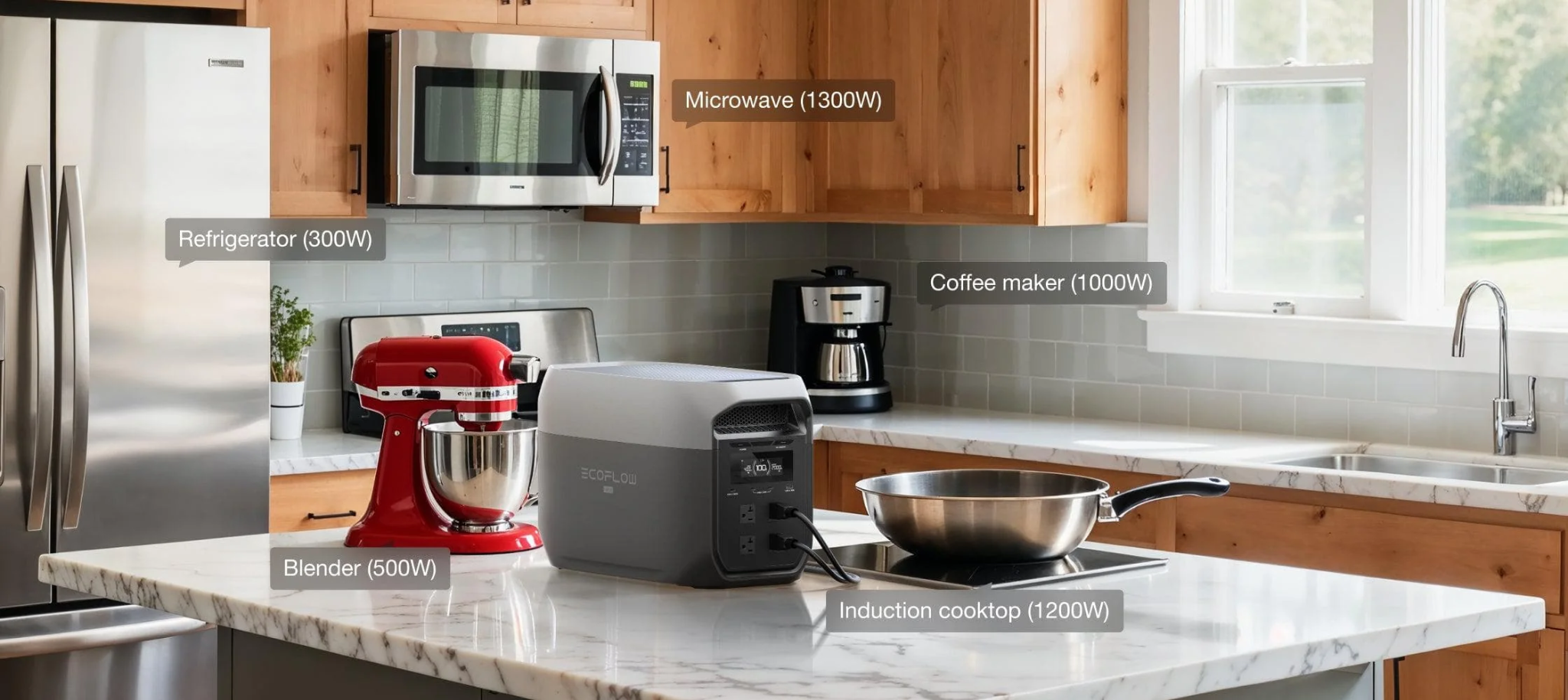Choosing the right portable power station isn’t just about finding a big battery—it’s about finding the right battery for your needs. Understanding watt-hours, watts, and device power requirements helps ensure you have enough energy when you need it most, whether you’re camping, traveling, or preparing for emergencies.
Why Capacity Matters
Capacity determines how long your portable power station can keep your devices running. Buy one that’s too small, and you’ll run out of power before you finish charging. Buy one that’s too big, and you’ll overspend or end up carrying unnecessary weight.
By learning a few simple terms—watts (W), watt-hours (Wh), and amp-hours (Ah)—you can confidently match your station to your lifestyle.
Understanding Watts vs. Watt-Hours
Let’s start with the basics.
- Watts (W) measure power output—how much energy your device uses at any moment. For example, a laptop might draw 60 W, while a coffee maker uses 1000 W.
- Watt-hours (Wh) measure capacity—how much total energy the battery can store and deliver over time.
Think of it like a car:
- Watts = speed (how fast energy is used).
- Watt-hours = fuel tank size (how far you can go).
A portable power station rated at 1000 Wh with a 1000 W inverter can deliver 1000 watts continuously for about one hour—or 100 watts for roughly ten hours.
Step 1: Identify Your Devices and Their Power Needs
Before choosing a model, list the devices you plan to power and note their wattage (usually found on the label or adapter). Common examples include:
| Device | Power (Watts) | Notes |
|---|---|---|
| Smartphone | 10 W | Around 100 recharges per 1000Wh |
| Laptop | 60 W | 12–14 hours runtime |
| Mini-fridge | 80–100 W | 8–10 hours per 1000Wh |
| CPAP machine | 40 W | 20+ hours per 1000Wh |
| LED lights | 10–15 W | 70–100 hours per 1000Wh |
| Coffee maker | 1000 W | Runs for 45–60 minutes |
| Microwave | 1200–1500 W | Requires higher inverter power |
Add up the wattage of all devices you might use at the same time. That’s your total load.
For example:
- Laptop (60 W) + mini-fridge (90 W) + light (10 W) = 160 W total draw.
A portable power station with a 500 Wh battery could power those devices for roughly three hours (500 ÷ 160 = 3.1).

Step 2: Know the Difference Between Continuous and Peak Power
When selecting a portable power station, check two numbers:
- Continuous Output (W) — the maximum sustained power it can deliver.
- Peak/Surge Power (W) — the temporary spike it can handle when devices start up.
Some appliances, like refrigerators and blenders, draw more energy for a few seconds when turning on. A station that supports a higher surge rating ensures stable performance.
For example:
A fridge rated at 100 W continuous might surge to 300 W at startup. In this case, a power station rated at 300 W continuous and 600 W peak would handle it easily.
Step 3: Estimate Daily Energy Usage
If you plan to camp or go off-grid for several days, calculate your total daily consumption in watt-hours.
Example:
- Phone: 10 W × 2 hours = 20 Wh
- Laptop: 60 W × 5 hours = 300 Wh
- Light: 10 W × 6 hours = 60 Wh
- Mini-fridge: 90 W × 10 hours = 900 Wh
Total = 1,280 Wh per day.
To comfortably meet this demand, choose a portable power station with at least 1,500 Wh capacity—or 2,000 Wh if you want backup for cloudy days or extra devices.
Step 4: Factor in Charging Options
Even the biggest battery is useless if it takes too long to recharge. Consider how you’ll top up your portable power station:
- AC Wall Outlet – Fastest method. Some models can go from 0% to 80% in under an hour.
- Solar Panels – Best for off-grid living. Check for solar input capacity (200–800 W) and MPPT controllers for higher efficiency.
- Car Charging (DC) – Slower, but handy on road trips.
If you rely heavily on solar, make sure the station supports a high input rate. For example, a 500W solar input can recharge a 1500Wh battery in roughly 3–4 hours of strong sunlight.
Step 5: Consider Battery Type and Longevity
Not all batteries are created equal.
- Lithium-ion (Li-ion): Common and affordable, but typically lasts 500–800 charge cycles.
- Lithium Iron Phosphate (LiFePO₄): Heavier, but safer and lasts 2,500–4,000 cycles.
If you plan to use your portable power station regularly—say for van life or home backup—LiFePO₄ models are a better long-term investment. They can handle daily use for nearly a decade with minimal degradation.
Step 6: Match Capacity to Your Use Case
Here’s a general breakdown of which capacity ranges fit different lifestyles:
| Use Case | Recommended Capacity | Typical Devices Powered |
|---|---|---|
| Everyday Carry / Emergency Kit | 200–500 Wh | Phones, tablets, lights |
| Weekend Camping / Short Trips | 500–1000 Wh | Laptops, coolers, small appliances |
| RV & Van Life | 1000–2000 Wh | Fridge, lights, fan, coffee maker |
| Home Backup / Power Outages | 2000–4000 Wh+ | Routers, TVs, refrigerators, tools |
Remember: it’s better to have a little extra capacity than to max out your battery every time. Running a portable power station to 0% frequently can reduce its lifespan.
Step 7: Portability and Weight
Higher capacity usually means heavier weight. A 300Wh power station might weigh 7 lbs, while a 2000Wh model could weigh 45 lbs or more.
If mobility matters—like for car camping or outdoor photography—aim for a balance between power and portability. Some models offer modular designs, allowing you to expand capacity by connecting extra batteries only when needed.
Step 8: Efficiency and Real-World Factors
Keep in mind that no battery operates at 100% efficiency. Power loss occurs during voltage conversion and inverter operation, usually 10–20%. Temperature, altitude, and cable length can also affect output.
To account for this, multiply your estimated energy need by 1.2 (20% buffer). For example, if your daily use is 1000Wh, choose a portable power station around 1200Wh to avoid running short.
Step 9: Future-Proof Your Choice
Your energy needs may grow over time. Maybe you’ll add a drone, an electric cooler, or another laptop. Investing in a slightly larger portable power station gives you flexibility for future upgrades without needing to replace your system.
Some modern units even allow firmware updates, Wi-Fi monitoring, or expandable batteries—making them smart long-term solutions for changing lifestyles.
Common Mistakes to Avoid
- Only looking at capacity. Output wattage and port types matter just as much.
- Ignoring recharge times. A slow recharge rate can be frustrating during emergencies.
- Overestimating solar charging. Weather and shading reduce panel efficiency.
- Running heavy devices continuously. It drains power faster than expected.
- Buying too small. It’s better to have 20% extra than to risk going dark.
Avoiding these mistakes ensures your portable power station always delivers when you need it most.
Conclusion
Choosing the right portable power station is about balance—enough capacity to power your devices, but still practical for your budget and mobility. Once you understand watts, watt-hours, and your daily energy habits, you’ll know exactly what to look for.
A little planning today ensures you’ll never be left in the dark—no matter where life takes you.

